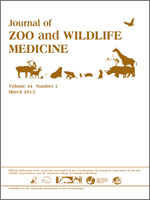Forty free-ranging white rhinoceros (Ceratotherium simum) were anesthetized with etorphine, azaperone, and hyaluronidase in Kruger National Park, South Africa, between February and August 2009. Eighteen rhinoceros received butorphanol in the dart combination, and 22 rhinoceros had butorphanol administered intravenously within 15 min of darting. Body position, blood gas values, heart rate, respiratory rate, and temperature were measured at two time points after darting, approximately 10 min apart (sample 1 mean collection time after darting, 9.4 ± 2.7 min; sample 2 mean collection time, 18.6 ± 2.8 min). A significant number of field-captured rhinoceros remained standing at the first sample period when butorphanol was administered in the dart. Higher median values for arterial partial pressure of oxygen (PaO2) in combination with lower arterial partial pressure of carbon dioxide (PaCO2) in standing versus recumbent rhinoceros suggested improved ventilation in this posture (P < 0.05). When the effect of time, body position, and age was controlled, median values for respiratory rate, lactate, and pH were better in rhinoceros that received butorphanol in the dart (P < 0.05). There was also a trend toward higher median values for SO2 and bicarbonate in rhinoceros receiving butorphanol in the dart. Intravenous administration of butorphanol resulted in significantly decreased median PaCO2 and heart rate in recumbent rhinoceros (P < 0.05) without changes in PaO2 between sample periods 1 and 2. However, rhinoceros remained hypoxemic during the short anesthetic procedure despite butorphanol administration. Preliminary results suggest that administration of butorphanol (either in the dart or intravenously) improves some metabolic parameters in free-ranging recumbent white rhinoceros without significantly affecting ventilation. It is hypothesized that this may be due to a lighter state of immobilization. Addition of butorphanol to the dart provides handling and physiologic advantages because the majority of rhinoceros remain standing.
How to translate text using browser tools
1 March 2013
USE OF BUTORPHANOL DURING IMMOBILIZATION OF FREE-RANGING WHITE RHINOCEROS (CERATOTHERIUM SIMUM)
Michele Miller,
Peter Buss,
Jenny Joubert,
Nomkhosi Mathebula,
Marius Kruger,
Laura Martin,
Markus Hofmeyr,
Francisco Olea-Popelka
ACCESS THE FULL ARTICLE
blood gas
butorphanol
cardiorespiratory effect
Ceratotherium simum
immobilization
white rhinoceros





